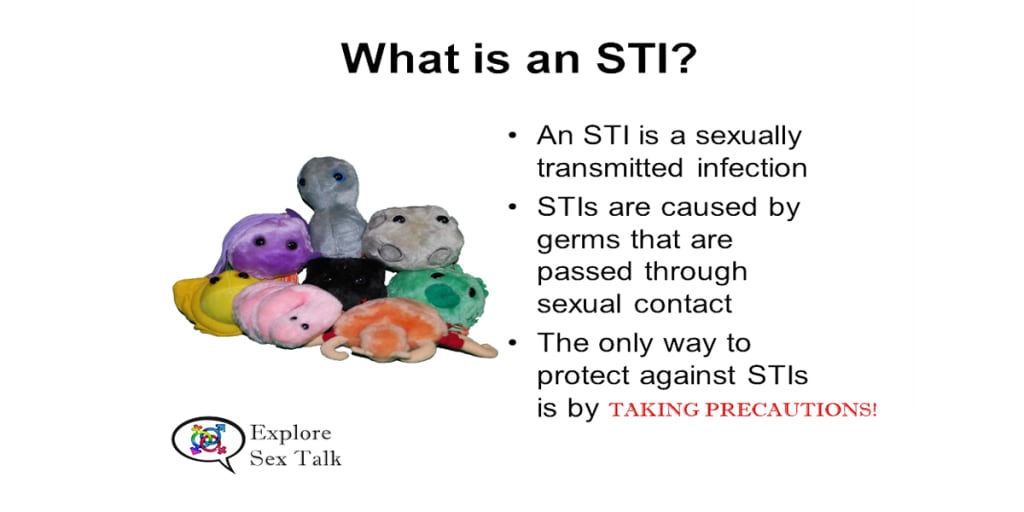What Is an STI?
And what's the difference from an STD?

An important part of being sexually active is protecting your sexual health. A lot of people’s first concerns are about unwanted pregnancies but there is another important reason to use safer sex methods: sexually transmitted infections. Sexually transmitted infections, or STIs, can cause a range of damage to the body from sores to infertility to death. Each STI has its own way of causing harm to the body and the symptoms may vary. It’s also common for many people to have a sexually transmitted infection and have no idea. Some infections do not present with any symptoms at all but they are still quietly doing damage under the radar.
There are lots of different types of infections that can occur and the ones we know the most about are: HIV/AIDS, chlamydia, gonorrhea, herpes, trichomoniasis, HPV, and syphilis. Based on available medical data from people being tested in Canada and the United States, STIs are a lot more common than most people realize.
What’s the Difference Between STIs and STDs?
The knowledge and language around sexually transmitted infections have changed a lot over the years. We have come to learn a lot more about each infection, how they are transmitted, what they do, and how they can be cured. In the past, we didn’t know about as many of the infections as we do now and the ones we used to know about were referred to as venereal disease (VD). As our knowledge expanded, the name was changed to sexually transmitted diseases (STDs). Today we call them STIs.
The change in language from disease to infection is because, thanks to modern medicine, many of them are not the death sentence they were once considered to be. We can cure a majority of the infections and are working on cures for the ones we currently can’t. Modern medicine has also developed drugs for incurable infections to be managed. We can minimize the impact of these infections on someone’s life. In some cases, we can do this so effectively that the person’s life is practically unaltered from someone who doesn’t have the infection, aside from the adjustment of their medical routine.
When treated, sexually transmitted infections are not a death sentence. They are no longer a disease in the same class as what we think of as a disease. We have more hope and options now. STD and STI are fairly interchangeable terms, they mean essentially the same things. The main difference is that using the terminology of STI acknowledges the advances of modern medicine and is less stigmatizing and traumatizing for people.
How Do I Know If I Have any STIs?
It’s important to know your sexual health status. Some STIs don’t have any symptoms and can develop to be life-threatening. It’s also important to know your status so you can ensure the safety of others around you. So how do you find out? Well, the good news is that we have a variety of medical tests to determine if people have any STIs. These tests range in complexity and invasiveness depending on what is being tested for. You may need to provide a blood or urine sample or sit for a physical exam. The type of test will be determined by what symptoms, if any, you have or what you are concerned about getting tested for.
How often you should get tested should be determined by your lifestyle and choices. If you are not really sexually active, not engaging in risky behaviors like needle sharing, or not working in any environments where you are regularly exposed to infections then your risk of getting an infection is much lower. You probably will not need to be tested very frequently. If you are enjoying multiple partners or engaging in lots of unprotected sex, it might be a good idea to get tested more regularly. How often you go should suit your individual needs.
Ignorance Is Not Bliss When It Comes to STIs
They say that ignorance is bliss but when it comes to sexually transmitted infections the truth is that ignorance could kill you. Learning about sexual health may be scary and uncomfortable but it’s an important part of adulting and taking care of yourself. Information about STIs has historically been used as scare tactics to keep young people from having sex. Sadly this scare tactic often only keeps people from really learning how to protect themselves for when they do have sex. Arm yourself with the best knowledge available to protect your health.
Enjoyed this article? Check out the other great articles, games, and more on my website
About the Creator
Teela Hudak
Teela is a Vancouver-based Sex Educator & Relationship Expert. Learn more at: https://exploresextalk.com/






Comments
There are no comments for this story
Be the first to respond and start the conversation.